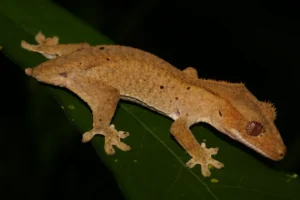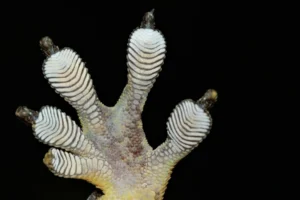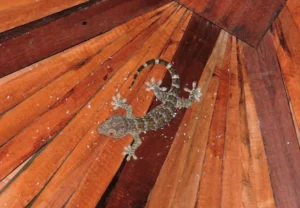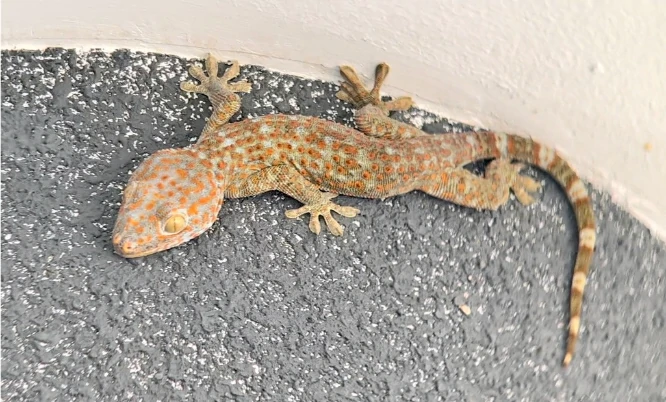If you’ve ever watched a gecko up close, you’ve probably noticed how smooth and shiny their skin looks in the light. They don’t have fur, but their feet can cling to walls like magic, and sometimes their skin looks a little bumpy. It makes you wonder, do geckos have tiny hairs hiding somewhere?
No, geckos don’t have real hair. They’re reptiles, not mammals, so their bodies are covered in scales, not fur. But if you look really close under a microscope, you’ll see hair-like projections called setae on their toes, and tiny spinules and bristles all over their skin. They can look like hair, but they’re not. These structures help geckos climb, protect their skin, and keep it clean.
To your eyes, a gecko looks completely hairless. Zoom in far enough though, and it’s like a tiny forest of microscopic structures.
Geckos Don’t Have Hair Like Mammals
Geckos aren’t mammals. That means their skin works differently. Mammals grow hair or fur from follicles, mostly to stay warm.
Geckos don’t need that because they’re cold-blooded and rely on the temperature around them to stay comfortable.

Instead of fur, geckos are covered in overlapping scales made of keratin, the same stuff your fingernails are made of.
These scales protect them from the sun, hold in moisture, and make their skin feel a little rubbery or velvety.
If you touch a gecko gently, it might feel smooth, but not slippery. The scales are small and packed close together, like shingles on a roof.
That’s why their skin looks bare, but it’s actually full of tiny detail.
So if geckos don’t have fur, what are all those tiny, hair-like things scientists talk about? That’s where it gets cool.
The Hair-Like Structures on Gecko Feet
If you could see a gecko’s toes under a microscope, you’d notice millions of tiny, hair-like filaments called setae.
Each one is about a tenth the thickness of a human hair, and at the end of each are hundreds of even smaller branches called spatulae.

Each foot has billions of these. They aren’t hairs, they’re part of the skin, made of keratin like the scales, but they look fuzzy up close.
These setae are what let geckos do their amazing climbing tricks, like walking up walls, ceilings, and even glass.
How Do Setae Help Geckos Stick to Surfaces?
People used to think geckos had sticky feet or used suction to cling to walls, but that’s not it. The real trick is something called van der Waals forces, which are tiny electrical pulls between molecules.
When a gecko’s spatulae touch a surface, they get close enough for these pulls to work.
Each one is weak, but when you add up millions of them, the gecko gets a super-strong grip. That’s how they can run across a ceiling without falling.

And when they want to let go, they just curl their toes upward and break those tiny bonds instantly. It’s simple but clever.
Even though it might look like geckos use hair to climb, they’re really using microscopic keratin structures that just happen to look like hairs.
The Hidden Hairs on Gecko Skin: Spinules and Bristles
Here’s something most people don’t know. Geckos don’t just have these tiny projections on their toes. Their whole body has them too.
Under a really strong microscope, scientists have found that gecko scales are covered in tiny hair-like things called spinules and bristles.
You can’t see them with your eyes, but they give the skin its special feel.
Spinules are tiny cone-shaped bumps that cover the skin evenly.
Bristles are a little longer and slimmer, sometimes around the edges of scales.
These aren’t for warmth like hair. They help in other ways. Spinules make the skin a little rough, so dirt and bacteria don’t stick easily.
They also help water bead up and roll off, taking dust and germs with it. It works like a built-in cleaning system.
If you’ve ever seen rain roll off a gecko’s back in perfect little beads, that’s the spinules at work. They help keep the skin healthy and clean.
Geckos don’t have hair, but they have tiny structures that make their skin very functional.
Why These Microscopic “Hairs” Matter
At first, these tiny bumps might seem unimportant, but they really help geckos survive.
For example:
-
Protection from bacteria: The rough texture makes it harder for bacteria to stick.
-
Water control: Spinules help keep them dry by pushing water off their skin.
-
Camouflage and reflection: The texture changes how light bounces off their skin, helping them blend in.
-
Self-cleaning: Dirt and dust don’t stick easily, so the gecko stays clean even in dusty places.
These microstructures act like tiny tools that keep geckos safe, clean, and efficient without fur or grooming.
Why Setae and Spinules Aren’t Real Hair
Even though setae on the feet and spinules on the body look like hair under a microscope, they aren’t the same.
Here’s the simple version:
-
Hair grows from follicles under the skin. Only mammals have those.
-
Setae and spinules grow straight out of the scales.
-
Hair helps mammals stay warm and feel things.
-
Setae and spinules help geckos climb, stay clean, and protect themselves.
Both hair and these tiny structures are made of keratin, but they do very different jobs. When people say geckos have “hair-like” projections, it’s just about how it looks, not what it does.
What Does Geckos Skin Feels Like?
Depending on the species, gecko skin can feel smooth, soft, or a little bumpy. A House gecko feels almost silky, while a Leopard gecko has small raised scales that feel grainy or velvety.

That texture comes from the scales and the tiny spinules and bristles. You can’t see them, but you can feel them when you touch a gecko gently.
And yes, geckos shed their skin regularly. They often eat it afterward. It’s a clever way to recycle nutrients and avoid leaving any trace for predators.
When they shed, all the tiny structures renew too, keeping the skin fresh.
Do Baby Geckos Have Hairs Too?
Baby geckos hatch with the same kind of skin as adults, scales, spinules, and all. They’re born with it. Even tiny hatchlings have the microscopic texture that protects and cleans their skin.
Their climbing ability starts early. Within days, young geckos can use their tiny setae-covered toes to climb smooth walls and escape danger.
It’s amazing that such tiny creatures come with such advanced biology right from the start.
What About Other Reptiles?
Like geckos, other reptiles such as snakes, lizards, and turtles don’t have hair. They rely on scales to protect them and control their temperature instead of fur.
Some reptiles also have tiny projections on their scales, though not all are as complex as geckos’.
These help with water movement, dirt resistance, and sometimes even color.
Hair just isn’t part of reptile biology. It wouldn’t work well for animals that need to change temperature by moving between sun and shade. Fur would only get in the way.
Can Humans Feel These Microscopic Structures?
Not really. Gecko spinules and setae are way too small to feel individually. If you hold a gecko gently, its skin might feel soft, slightly textured, or smooth, but you won’t feel the tiny bumps themselves.
They’re part of a microscopic world, but the effects like water rolling off or sticking to glass are easy to see.
Do Gecko Setae or Spinules Ever Wear Out?
Yes, over time they can wear down, especially in older geckos or ones that live in rough areas. But geckos shed and renew their skin regularly, including their setae and spinules.

Every new layer of skin restores their climbing power and self-cleaning surface.
It’s like a natural tune-up every time they shed.
Why Geckos Don’t Need Hair
Hair helps mammals stay warm, but geckos don’t need that. They control their temperature by behavior, basking in sunlight when cold and hiding in shade when warm.
Their scales and tiny projections give them everything they need, protection, cleanliness, flexibility, and camouflage. Hair wouldn’t help at all.
Conclusion
Geckos don’t have hair, not even a little. What they do have are incredible microscopic structures that make their skin and feet work like a living machine.
Their toe pads are covered with millions of setae, letting them walk on glass and hang upside down.
Their skin is coated with spinules and bristles, which protect them, repel water, and keep them clean.
None of these are real hairs, they’re special parts of the scales that do what fur could never do.
Next time you see a gecko clinging to your wall or hiding under a porch light, remember this. That smooth skin isn’t simple at all.
It’s covered in tiny, hair-like details that help geckos survive, stay clean, and keep climbing, all without a single real hair.
Hi, my name is Ezra Mushala, i have been interested animals all my life. I am the main author and editor here at snakeinformer.com.

